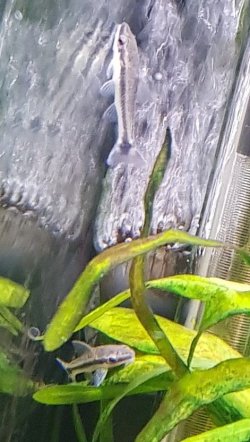Some data on species I researched a while back that may be of interest.
Otocinclus macrospilus
The identification of the specific species of oto in the home aquarium is not always easy as there are several with very similar patterns and the names attached to them in stores are frequently inaccurate. Fortunately the care and behaviour is basically identical whichever species you may have in your aquarium. No Otocinclus species possesses an adipose fin, but this fin is present on the species in the closely-related Paratocinclus genus.
Otocinclus macrospilus is probably the species most often encountered in the hobby; this species is often mis-identified as O. affinis [see comments below]. It is strikingly similar to O. vestitus and can be distinguished by the markings on the caudal (tail) fin. O. macrospilus has a distinctive large round black blotch at the base of the caudal fin; on O. vestitus the horizontal black band extends onto the caudal fin with no significant enlargement into a blotch. O. vittatus is another near-identical species, but the upper edge of the black horizontal band along the sides of the fish is bordered by a distinct white clear band separating the black band from the mottled pattern; on O. macrospilus the white band is less distinct in places and on O. vestitus the mottled pattern adjoins the black band with no definable white band.
There are several oto species that mimic the patterning of sympatric Corydoras species. Otocinclus mimulus, O. flexilis, O. affinis and O. xakriaba are considered to be mimics of Corydoras diphyes, C. paleatus, C. nattereri and C. garbei respectively [Axenrot & Kullander, 2003]. Mimetic association means the imitation or mimicry in pattern between the two species; sympatric species are those living in the same geographical habitat.
The species was described in 1942 by C.H. Eigenmann and W.R. Allen. The genus name [erected by Cope in 1871] is derived from the Greek oto [ear] and the Latin cinclus [a latticework], referring to the holes in the head in the region of the ears.
As mentioned previously, this species is often seen under the name Otocinclus affinis. In 2001, I.J.H. Isbrucker et.al. proposed the genus Macrotocinclus for O. affinis and O. flexilis on the basis that these two species form a clade according to S.A. Schaefer's 1997 study; the latter is now regarded as remaining in Otocinclus but Macrotocinclus affinis is accepted [see Eschmeyer, the California Academy of Sciences database].
The genus Otocinclus was erected by Cope in 1871. In 1997, Scott A. Schaefer revised the genus, recognizing only 13 of the original 65 species; the others he re-assigned to various genera. Since then, three new species have been described as Otocinclus, bringing the genus total to 16 valid species. The phylogenetic biogeography of Otocinclus led Schaefer to suggest that much of the generic and species-level diversification of the Otocinclus and perhaps other loricariid catfishes occurred prior to the formation of the Amazon basin [Schaefer, 1997]. The phylogenetic relationships among the fish in the subfamily Hypoptopomatinae are currently under study, and the genus Otocinclus may eventually be relocated [Lehmann, 2006].
References:
Axenrot, Thomas E. & Sven O. Kullander (2003), "Corydoras diphyes (Siluriformes: Callichthyidae) and Otocinclus mimulus (Siluriformes: Loricariidae), two new species of catfishes from Paraguay, a case of mimetic association," Icthyological Exploration of Freshwaters 14(3), pp. 249-272.
Isbrucker, I.J.H., I. Seidel, J.P. Michels, E. Schraml & A. Werner (2001), "Diagnose vierzehn neuer Gattungen der Familie Loricariidae Rafinesque, 1815 (Teleosti, Ostariophysi)," DATZ, Sonderheft Harnischwelse 2, pp. 17-24.
Lehmann, Pablo A. (2006), "Otocinclus batmani, a new species of hypoptopomatine catfish (Siluriformes: Loricariidae) from Colombia and Peru," Neotropical ichthyology, volume 4, number 4.
Schaefer, Scott A. (1997), "The Neotropical cascudinhos: Systematics and biogeography of the Otocinclus catfishes (Siluriformes: Loricariidae)," Proceedings of the Academy of Natural Sciences of Philadelphia, 148, pp. 1-120.




 happy Oto day
happy Oto day 
